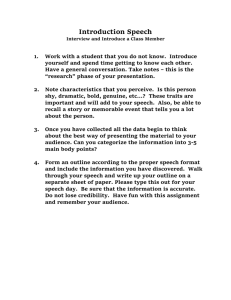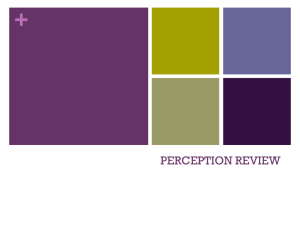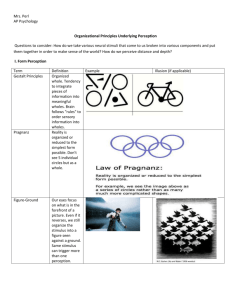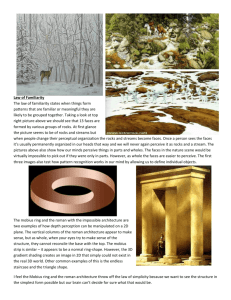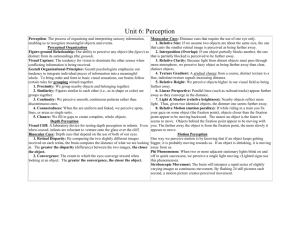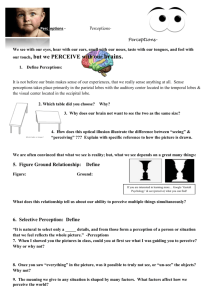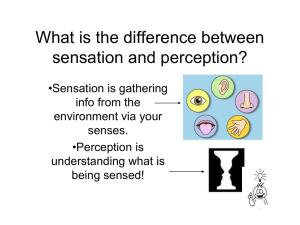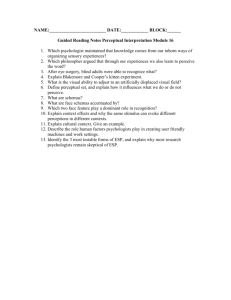Direct realism
advertisement
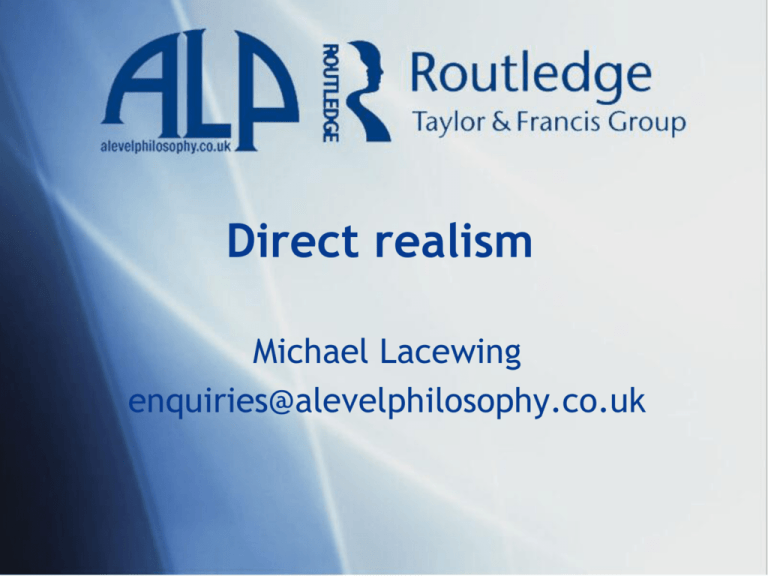
Direct realism Michael Lacewing enquiries@alevelphilosophy.co.uk What do we perceive? • Direct realism: we perceive physical objects, which exist independent of our experience – Physical objects existed before minds – They continue to exist when not being perceived. • I perceive physical objects and their properties – size, shape, colour, smell, texture, taste, etc. Russell’s table • What we perceive isn’t the same as what exists ‘out there’. • Russell: a shiny brown table doesn’t look the same colour all over – What colour any part looks depends on where you stand? – Why say its brown is more a real property of the table than the other colours you see? Russell’s table • The same can be said about other properties we perceive – smooth (microscopically bumpy), rectangular (perspective effects). • There is an appearance/reality distinction. • What we perceive ‘immediately’ or ‘directly’ is not the physical object and its properties. Do the corners look 90 degrees? The argument from perceptual variation • There are variations in perception. • Our perception varies without corresponding changes in the physical object we perceive. (For instance, the desk remains rectangular, even as the way it looks to me changes as I look at it from different angles.) • Therefore, the properties physical objects have and the properties they appear to have are not identical. • Therefore, what we are immediately aware of in perception is not exactly the same as what exists independently of our minds. • Therefore, we do not perceive physical objects directly. Sense data • Sense-data: the content of my sensation, appearances – e.g. the colour and shape of the desk as I see it now. • Sense-data are distinct from the physical object – e.g. they are not independent of being perceived – They vary while the physical object does not. • The objection to direct realism: we immediately or directly perceive sense-data not physical objects. The direct realist’s reply • The colour of the table (brown) is the colour it appears to have when seen by normal observers under normal conditions – This is what it means to talk of colour – We don’t always see what colour it is – But when we see its (normal) colour, we see the table and its properties. • Likewise with shape: it is rectangular, even if it doesn’t always look rectangular. Relational properties • In perception, we can be aware of a range of properties, some which the object has independent of our minds, and some of which it has in relation to being perceived. • ‘Looking obtuse’ is a ‘relational property’ - a property a rectangular desk can have in relation to being perceived – Compare: ‘being to the north of’ – a property something has, but only in relation to some other thing. • We don’t need to think sense-data exist to explain what we perceive. The crooked pencil • A pencil half-submerged in water looks crooked but is straight. • Just from what you see, you can’t tell whether you are seeing an illusion – Illusions can be ‘subjectively indistinguishable’ from veridical perception. The argument from illusion • We perceive something having some property, F (e.g. a stick that is crooked). • When we perceive something having some property F, then there is something that has this property. • In an illusion, the physical object does not have the property F (the stick is not crooked). • Therefore, what has the property F is something mental, a sense-datum. The argument from illusion • Therefore, in illusions, we see sense-data, and not physical objects, immediately. • Illusions can be ‘subjectively indistinguishable’ from veridical perception. • Therefore, we see the same thing, namely sense-data, in both illusions and veridical perception. • Therefore, in all cases, we see sense-data, and not physical objects, immediately. • Therefore, direct realism is false. Reply • Relational properties again: when the pencil in water looks crooked, there is nothing that is crooked. The pencil has the property of looking crooked. • Sometimes we perceive the ‘looks’ properties of physical objects, sometimes we experience the properties they have that don’t relate to how they are perceived – In both cases, we directly perceive physical objects and their properties. The argument from hallucination • In a hallucination, we perceive something having some property F. • When we perceive something having some property F, then there is something that has this property. • We don’t perceive a physical object at all (unlike the case of illusion). • Therefore, what we perceive must be mental – sense-data. The argument from hallucination • Hallucinations can be experiences that are ‘subjectively indistinguishable’ from veridical perceptions. • Therefore, we see the same thing, namely sense-data, in both hallucinations and veridical perception. • Therefore, in all cases, we see sensedata, and not physical objects, immediately. • Therefore, direct realism is false. The disjunctive theory of perception • The direct realist can’t say that what is seen is how some physical object looks, because no physical object is seen at all! • The disjunctive theory of perception: if something looks a certain way, then one of two quite different things is going on: – Either I directly perceive a mind-independent physical object that is F – Or (as in the case of hallucination) it appears to me just as if there is something that is F, but there is nothing that is F. The disjunctive theory of perception • Hallucinations and veridical perception are two completely different kinds of mental state – They can seem exactly the same, but that doesn’t prove that they are the same. • Hallucinations tell us nothing about perception – E.g. in hallucination, we don’t perceive anything, we imagine it. • Therefore, the argument from hallucination is no objection to direct realism. The time-lag argument • It takes time for light waves, or sound waves, or smells, to get from physical objects to our sense organs. • We can perceive something even after it ceases to exist (e.g. distant stars). • Therefore, we aren’t perceiving physical objects directly. Reply • What is said to be perceived here is itself physical, e.g. light waves – Should we say that we perceive physical objects indirectly, and the physical medium (light, chemicals) directly? • This is a confusion between what we perceive and how we perceive. Seeing light • Compare: – ‘Can you see the lake?’ and ‘Can you see the light reflecting off the lake?’ – ‘Can you see paper?’ and ‘Can you see the light reflecting from the paper?’ • To ‘see’ the light that the paper reflects is just to see the paper. • Except in special conditions, we don’t perceive light waves directly and physical objects indirectly. • The time-lag argument only shows that we literally perceive the past. Common sense • Describe what you see. Try to describe your experience in terms of sense-data, without referring to any physical objects – It is virtually impossible for any normal scene. • Our perceptual experience presents what we perceive as mind-independent objects. • That doesn’t prove that we perceive mindindependent objects, but it does make such a claim highly intuitive. • Only direct realism holds onto this basic intuition.

